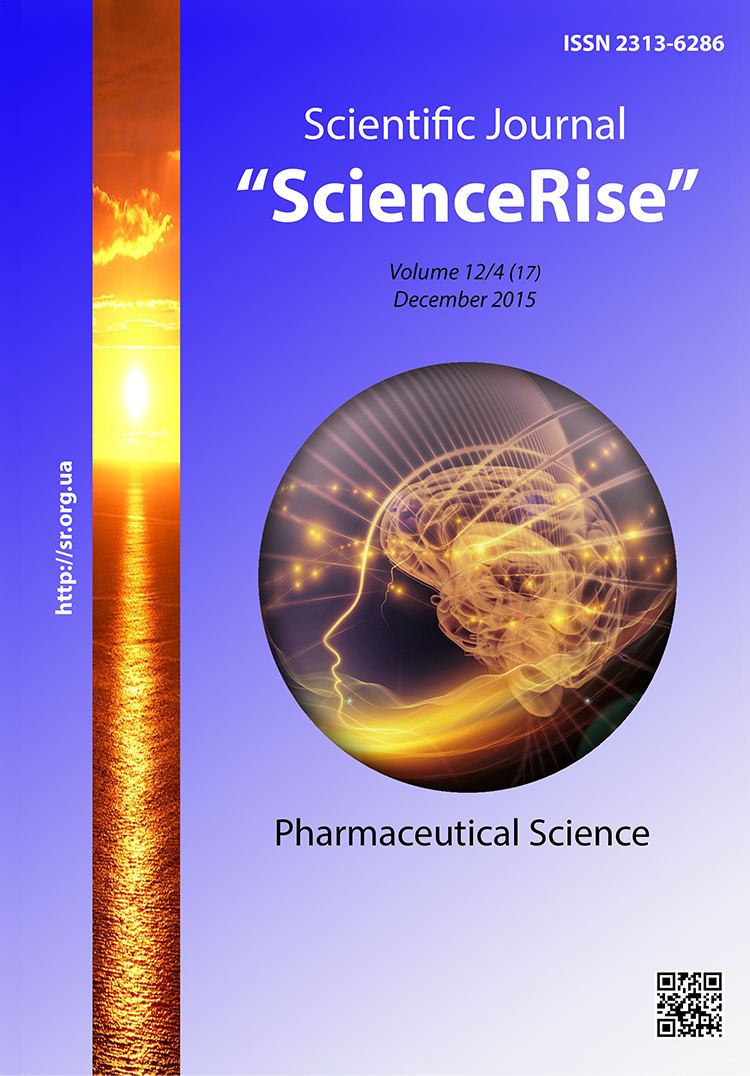Современное состояние ассортимента лекарственных средств для лечения вагинального кандидоза
DOI:
https://doi.org/10.15587/2313-8416.2015.56942Ключові слова:
ассортимент, фармацевтический рынок, маркетинговые исследования, лекарственные средства, вагинальный кандидоз, флуконазолАнотація
На сегодняшний день проблема лечения вагинального кандидоза и создание эффективных лекарственных препаратов для лечения данного заболевания является актуальной для современной гинекологии и фармации.
Цель: Исследовать ассортиментную структуру лекарственных средств для лечения вагинального кандидоза, представленных на украинском фармацевтическом рынке.
Методы: Статистические и маркетинговые методы исследований электронных и бумажных источников информации. Анализ ассортимента осуществлён на основании материалов Государственного реестра лекарственных средств Украины и Компендиума.
Результаты: В лечении вагинального кандидоза самая большая эффективность принадлежит флуконазолу. Согласно АТС-классификации лекарственные средства с флуконазолом представлены двумя анатомическими группами, среди которых основную долю составляют препараты для системного применения. На фармацевтическом рынке Украины зарегистрировано 103 лекарственных препарата с флуконазолом, которые представлены в основном импортными производителями. Наибольшую долю препаратов (84,8 %) составляют твердые лекарственные формы (капсулы и таблетки).
Выводы: Вагинальные лекарственные препараты с флуконазолом на рынке Украины вообще отсутствуют. Учитывая, что суппозитории имеют ряд преимуществ над другими лекарственными формами, создание новых лекарственных препаратов с флуконазолом является перспективным направлением для современной медицины и фармации
Посилання
Jarnyh, T. G., Levachkova, Ju. V., Chushenko, V. M., Skyter, S. M. (2014). Pat. na korysnu model' № U93885, MPK (2014) A 61K36/71, A61R15/02. Zasib u formi pesarii'v dlja likuvannja ginekologichnyh zahvorjuvan'. Zajavn. i patentovl. NFaU. № u 2014 03030; declared 25.03.14; published 27.10.2014. Bjul.. № 20, 4.
Dudko, V. L., Lahno, I. V., Storchak, A. V., Grishhenko, O. V., Dudko, L. V., Lisicina, N. V. (2006). Nekotorye aspekty jepidemiologii i perspektivy lechenija vaginal'nogo kandidoza v sovremennyh uslovijah. Visnik Harkivs'kogo nacional'nogo universitetu im. V. N. Karazina, 720. Ser.: Medicina, 12, 61–66.
Petersen, Je. Je. (2007). Infekcii v akusherstve i ginekologii. Moscow: MEDpress-inform, 104–112, 158–161.
Stock, I. (2010). Fungal diseases of vulva and vagina caused by Candida species. Med. Monatsschr. Pharm., 33 (9), 324–333.
Fedotov, V. P., Tuljakova, E. F., Gorbuncov, V. V., Mamon, A. A., Dzhybryl', V. A., Pylypenko, A. A., Korshun, Y. G. (2003). Pymafucyn v terapyy vagynal'nogo kandydoza. Ukrai'ns'kyj zhurnal dermatologii', venerologii', kosmetologii', 3, 81–82.
Reznichenko, N. O. (2005). Suchasna diagnostyka grybiv rodu Sandida. Bukovyns'kyj medychnyj visnyk, 9 (3), 161–165.
Evseev, A. A. (2009). Sovremennye principy diagnostiki i lechenija vaginal'nogo kandidoza. Vestnik reproduktivnogo zdorov’ja, 20–25.
Esim Buyukbayrak, E., Kars, B., Karsidag, A. Y. K., Karadeniz, B. I., Kaymaz, O., Gencer, S. et. al. (2010). Diagnosis of vulvovaginitis: comparison of clinical and microbiological diagnosis. Archives of Gynecology and Obstetrics, 282 (5), 515–519. doi: 10.1007/s00404-010-1498-x
Ilkit, M., Guzel, A. B. (2011). The epidemiology, pathogenesis, and diagnosis of vulvovaginal candidosis: A mycological perspective. Critical Reviews in Microbiology, 37 (3), 250–261. doi: 10.3109/1040841x.2011.576332
Ivleva, A. Ja., Poplavko, R. M., Leshkova, R. M., Grishkova, E. A. (1997). Medofljukon (fljukonazol) – poslednee dostizhenie v lechenii mikozov. Vestnik dermatologii i venerologii, 3, 63–66.
Mel'nykova, N. V., Fukleva, L. A., Puchkan, L. O., Zhadan, I. S., Loboda, O. S., Lytvynenko, T. M. (2010). Poshuk novyh likars'kyh zasobiv dlja suchasnoi' ginekologii'. Aktual'ni pytannja farmacevtychnoi' i medychnoi' nauky ta praktyky, 1, 61–63.
Skyter, S. M., Levachkova, Yu. V., Chushenko, V. M. (2014). Marketing researches of drugs on a fluconazole for a treatment of vaginal candidosis. Actual Questions Of Development of New Drugs: Abstracts of XX International Scientifi c And Practical Conference Of Young Scientists And Student. Kh.: Publishing Office, 115
Mihajlec, N. V., Svjatenko, T. V. (2010). Racional'nye podhody k vyboru mestnogo antimikoticheskogo sredstva. Ukrains'kij zhurnal dermatologіi, venerologіi, kosmetologіi, 1, 70–75.
European Pharmacopoeia. 5th ed. (2005). Suppl.4.4, 3503.
Kovalenko, V. N. (Ed.) (2013). Kompendium 2013 – lekarstvennye preparaty. Kyiv: Morion, 2360.
Derzhavnyj reestr likars'kyh zasobiv. Available at: http://www.drlz.kiev.ua/
Zamors'kyj, I. I. (2011). Systemni antymikotyky: mozhlyvosti farmakoterapii' v Ukrai'ni. Klinichna ta eksperymental'na patologija, 4, 157–158.
Levachkova, Ju. V., Chushenko, V. N., Pushok, S. N. (2015). Perspektivy razrabotki lekarstvennogo preparata na osnove masla amaranta dlja lechenija vospalitel'nyh ginekologicheskih zabolevanij. Tezisy VII mezhdunar. nauchno-prakticheskoj konf. «Academic science – problems and achievements». North Charleston, USA, 2, 224–225.
Levachkova, Ju. V. (2009). Zapal'ni zahvorjuvannja v ginekologii': klasyfikacija, etiologija, patogenez. Klinichna farmacija, 13 (3), 18–20.
Kosilova, S. Je. (2011). Poshuk novyh pryncypiv likuvannja hronichnogo kandydoznogo vul'vovaginitu. Klinichna ta eksperymental'na patologija, 4 (38), 168.
Kruts'kyh, T. V., Strilec', O. P., Bur’jan, K. O., Bur’jan, G. O. (2010). Pat. na vynahid № U91423. Farmacevtychna kompozycija u vygljadi vaginal'nyh supozytorii'v. Declared 17.11.2008; published 26.07.2010, Bjul. № 14.
##submission.downloads##
Опубліковано
Номер
Розділ
Ліцензія
Авторське право (c) 2015 Юлия Валентиновна Левачкова, Татьяна Григорьевна Ярных, Валентина Николаевна Чушенко, Снежана Николаевна Пушок

Ця робота ліцензується відповідно до Creative Commons Attribution 4.0 International License.
Наше видання використовує положення про авторські права Creative Commons CC BY для журналів відкритого доступу.
Автори, які публікуються у цьому журналі, погоджуються з наступними умовами:
1. Автори залишають за собою право на авторство своєї роботи та передають журналу право першої публікації цієї роботи на умовах ліцензії Creative Commons CC BY, котра дозволяє іншим особам вільно розповсюджувати опубліковану роботу з обов'язковим посиланням на авторів оригінальної роботи та першу публікацію роботи у цьому журналі.
2. Автори мають право укладати самостійні додаткові угоди щодо неексклюзивного розповсюдження роботи у тому вигляді, в якому вона була опублікована цим журналом (наприклад, розміщувати роботу в електронному сховищі установи або публікувати у складі монографії), за умови збереження посилання на першу публікацію роботи у цьому журналі.

